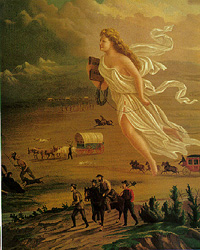In the last decades of the nineteenth century
Native Americans suffered countless assaults and indigneties under a brutal, and
congressionally mandated, program aimed at incorporating the Native American into
mainstream America. This period, known as the Gilded Age, was in fact the age of
incorporation, a time when developments like the railroad and the telegraph made the vast
United States a smaller and more manageble place. Americans were introduced to national
brands, national corporations, and national pastimes as they developed an increasingly
incorporated national culture. The message sent by the White City at the Columbian Fair of
1893, "the first expression of American thought as unity," represented the
fulfillment of an incorporated American culture(Trachtenberg 220).
Not all Americans shared in this unity of thought. Chief Simon Pokagon, whose
family had originally owned the section of Chicago upon which the White City was built,
wrote the "Red Man's Rebuke" in order to vent his frustration at lack of
representation accorded to the first Americans. As thier relative absence from the Fair's
exhibits suggests Native Americans remained unincorporated in the age of incorporation.
Yet in this generic age mainstream white America worked
hard to force Native Americans to assimilate and take thier place among the already
incorporated. The experience of the Native American in this period, a time defined by the
massacre of hundreds at Wounded Knee
and the assassination and imprisonment of thier leaders most notably Crazy Horse and Geronimo, illustrates the extreme nature of the
forced assimilation of thier culture.

As John Gast's painting "American Progress"(shown above)
suggests the traditional Native American, a dying breed even at the onset of the Gilded
Age, remained cast as the "savage other," the outsider, and signified, to the
agents of incorporation, a road block to the "grand drama of progress." Native
American warriors like Sitting Bull, Chief Joseph, and
Geronimo remained the enemies of incorporation.
Native Americans represented a special problem to those who sought
to incorporate the west and saw the land as a resource to be exploited. In The Incorporation of America
Alan Trachtenberg explains the problem posed by Native Americans to the agents of
incorporation: "The Indian projected a fact of a different order from land and
resources: a human fact of racial and cultural difference not as easily incorporated as
minerals and soil and timber"(27).
Thus in the Gilded Age white Americans were increasingly interested
in solving the so-called "Indian problem and attempted through various means to
figure out "how to get rid of it in the easiest and quickest way possible, and to
bring the Indian and every Indian in to" their incorporated culture.
The agents and agencies of incorporation took various forms. In 1887
the movement to forcibly incorporate the Native Americans was legalized when Congress
passed the Dawes Severalty or General
Allotment Act. The Dawes Act offered Native Americans a choice between thier own
legally sanction extinction and incorporation. It, according to Alan Trachtenberg:
| "implied a theory and pedagogical vision of America
itself.....manifested in practical terms. To every male Indian 'who has voluntarily taken
up ....his residence apart from any tribe... and has adopted the habits of civilized[read
white] life,' the act offered not only an allotment of land for private cultivation but
the prospect of full American citizenship. It offered a choice: either abandon Indian
society and culture, and thus become a 'free' American, or remain an Indian socially and
legally dependent.
|
NEXT: THE NATIVE AMERICAN IN POPULAR CULTURE


